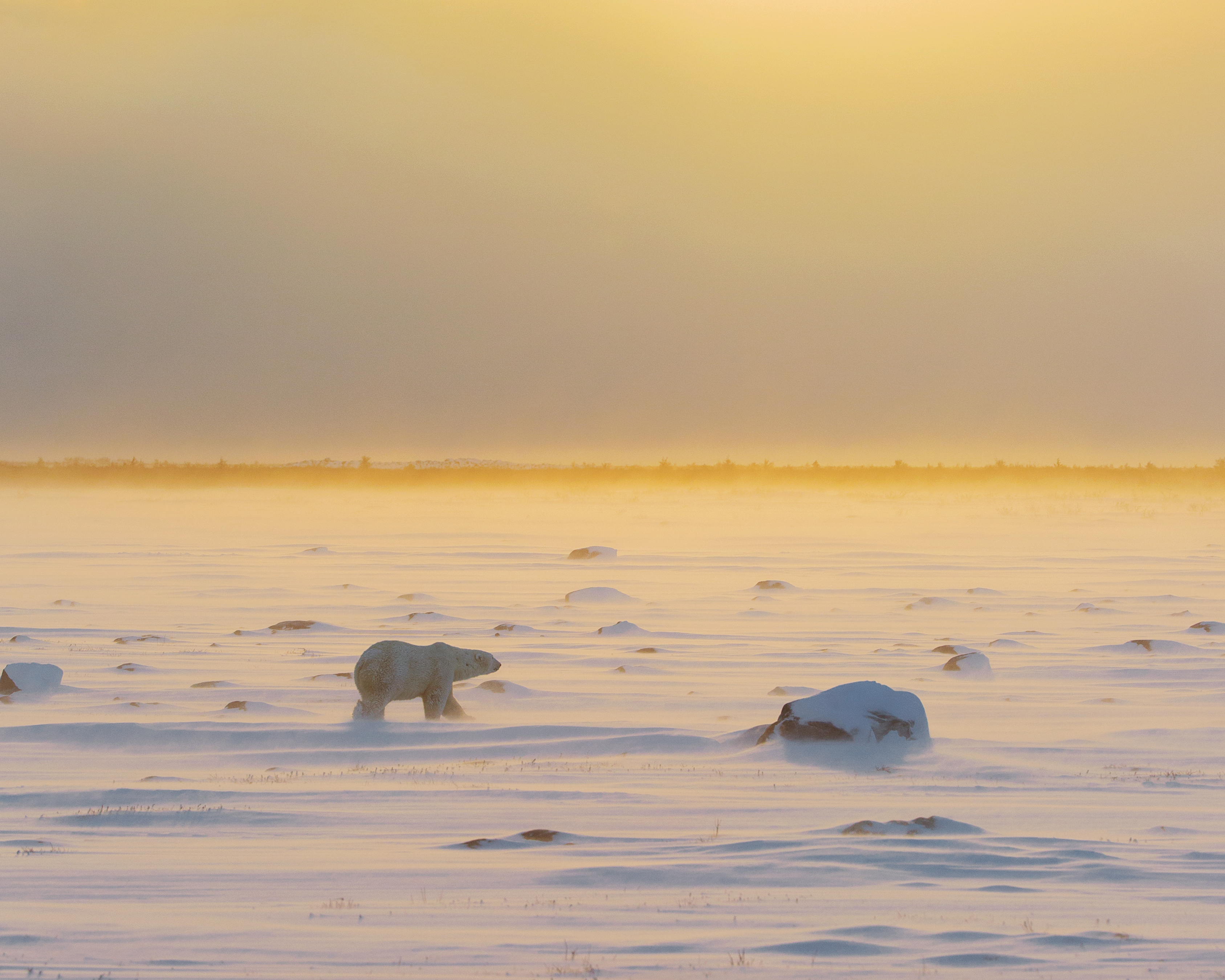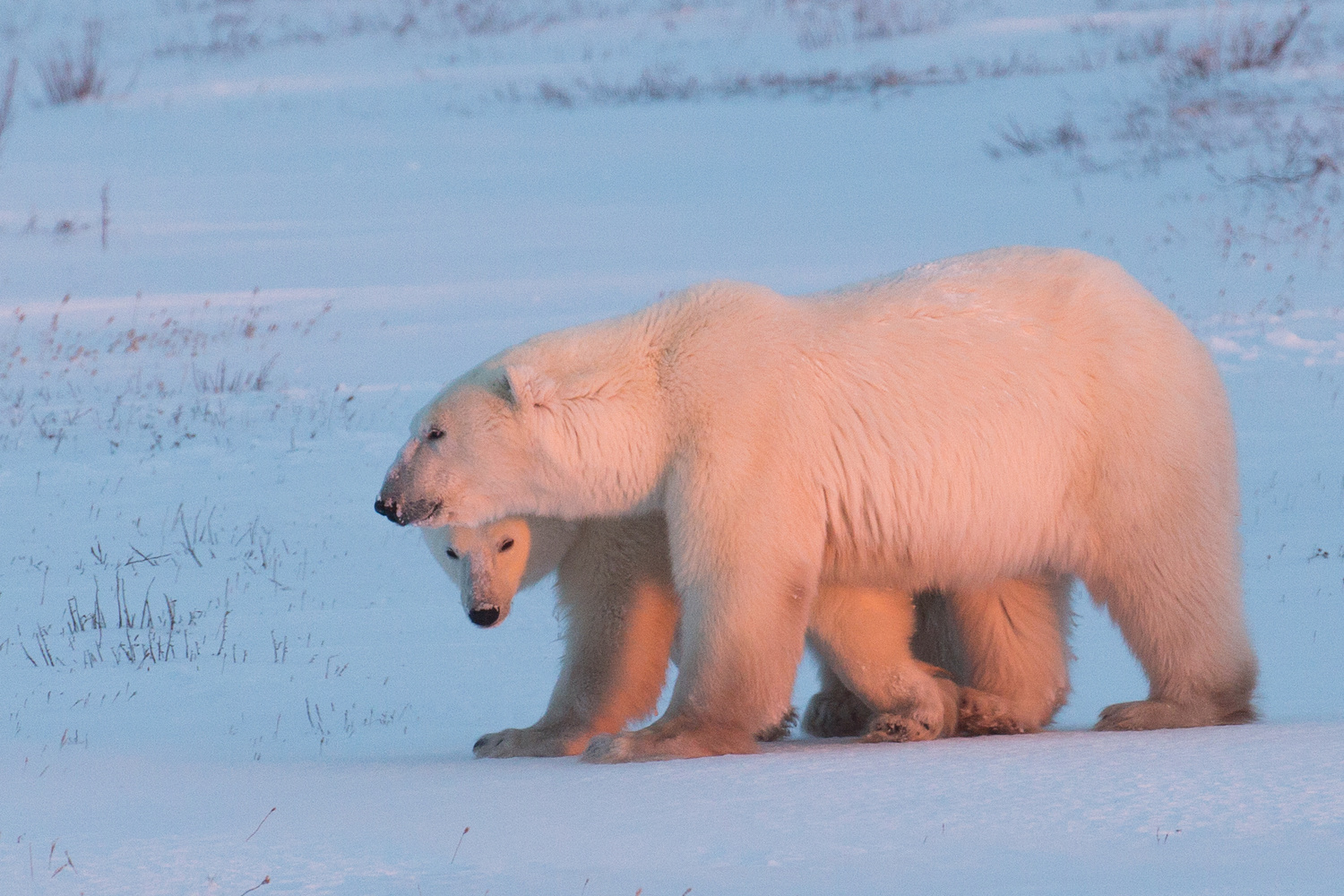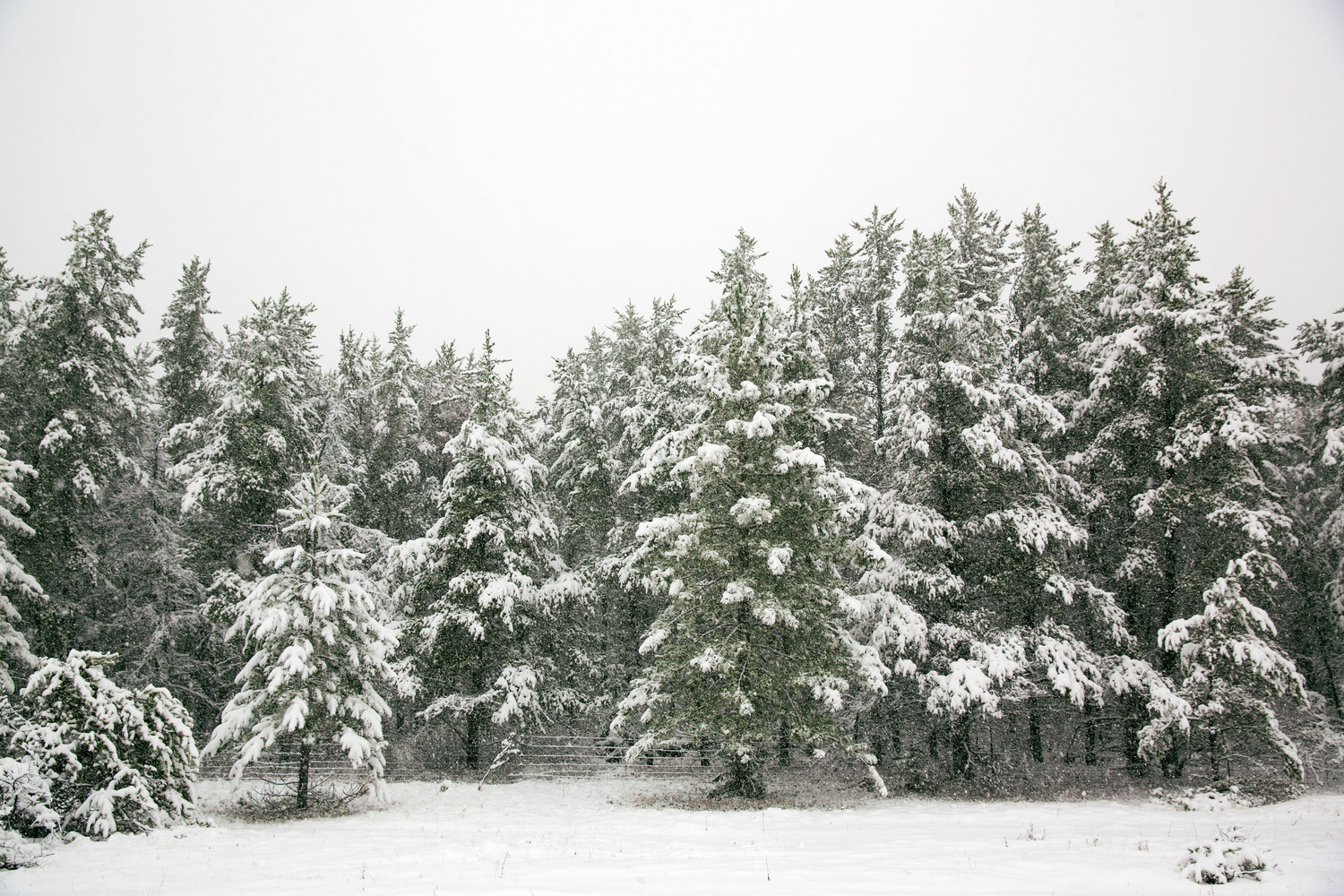Have you ever thought of taking a trip to the sub-Arctic or Arctic to photograph polar bears and their habitat? Ever thought it might be your destiny to come nose-to-nose with the largest predator living on land? My latest article for Bradt Guides' Travel Club is all about taking photos of polar bears and their environment. I thought I'd share some of the tips and photos here.
I'm going to talk about gear, settings, preparation, wildlife behaviour, and the importance of choosing an excellent operator.
Getting There
Getting north to see and photograph polar bears in their natural environment is no easy task.
 First, consider that polar bears are dangerous. The biggest male polar bears can average up to 700 kg. Combined with a jaw that has about 1,200 psi of crushing force, their canines reach over 5 cm long. They have paws that measure 30 cm across, topped by claws that grow to 10 cm. Let's also keep in mind that polar bears can run 40 km/h, faster than world-record pace. Wandering the tundra unguided looking for polar bears is a really bad idea. You’re going to need an expert.
First, consider that polar bears are dangerous. The biggest male polar bears can average up to 700 kg. Combined with a jaw that has about 1,200 psi of crushing force, their canines reach over 5 cm long. They have paws that measure 30 cm across, topped by claws that grow to 10 cm. Let's also keep in mind that polar bears can run 40 km/h, faster than world-record pace. Wandering the tundra unguided looking for polar bears is a really bad idea. You’re going to need an expert.

There are two major and accessible places where polar bears live in sufficient numbers to make finding them worth the trip: Churchill and Svalbard. The sub-Arctic town of Churchill, Manitoba is considered the polar bear capital of the world. You'll find Churchill at the end of your choice of a two-day train trip or a two-and-a-half hour flight. No roads lead to Churchill. Likewise, the only ways to get to Svalbard are a multi-day sail or a three-hour flight from Oslo. Once you’re in Churchill or on Svalbard, you’re going to have to find a way to get out of town and close to the water, and further away from the conveniences of modern travel.
It’s best to aim for a visit with the polar bears in Churchill just as the sea ice is starting to freeze. The bears congregate on shore, eager to get onto ice that will support their hunt for seals. This gathering means there is a higher chance of great viewings and of bear-to-bear interactions. In Svalbard, you’re aiming for the moment when the ice reaches its lowest ebb. This gives the ships greater freedom of movement to track single bears or sail into stunning fjords. However, given climate change over the last couple of decades, trying to time that precise moment of the freeze or melt has gotten harder and harder. Again, this is where an expert will come in handy.

It's cold that far up north. Really cold. Churchill in November has an overnight low around -20 C and daytime highs of a balmy -9 C, dropping closer to -20 C by the end of the month. Svalbard, though more temperate, is still cold. The best time to catch the ice melt in Svalbard is September. At that time of year, temperatures hover right around freezing.
If you’re going to go to this kind of effort, make sure that you’re prepared to capture the best possible photos of the bears, their wildlife friends, and the barren landscapes they live in.
Protecting Fragile Ecosystems
You can’t really experience the sub-Arctic and Arctic without professional assistance. These are fragile ecosystems. Make sure that you’re selecting a team that will take care of you and of the places you’re visiting.
If you’re heading to Churchill, check out Frontiers North Adventures, an internationally recognized leader in authentic and sustainable adventures in Canada’s North. The family-owned and operated Certified B Corporation, Frontiers North Adventures, hosts guests primarily in and around the sub-Arctic community of Churchill, Manitoba. Frontiers North Adventures can help you dine beneath the northern lights, sing alongside beluga whales, and lock eyes with wild polar bears. My most recent trips to see the polar bears have been with Frontiers North Adventures. From my perspective, their programs are meaningfully designed for wildlife and culture enthusiasts, photographers, and experiential adventure travellers.
Gear
The Cold
As I explained, visiting the Arctic and sub-Arctic is cold. If you’re hoping to see large numbers of polar bears on the continental tundra, you’re going to have to be prepared for plummeting temperatures.
As photographers, we all know that batteries lose their charge faster in the cold. Make sure that your extra batteries stay warm by placing them in an inside pocket and add a hand warmer to keep your charge from dwindling.
Use your gear back wisely. If you’re outside in -15 C and then go back inside, your gear will fog over as it rapidly warms up. Doing this will eventually lead to moisture problems, not good for your lenses. Instead, put your gear in a bag while you’re still outside. When you go inside, it will warm up slowly. Instead of dew forming on your gear, it will form on your bag. As an alternative, if it’s safe to do so, leave your bag outside in the cold, then your gear won’t be exposed to multiple cycles of cooling and heating.
In terms of dealing with inclement weather, make sure you have a hood or poncho for your camera. When it starts to snow, you can keep shooting without worrying about your gear getting wet. A streaking fox silhouetted in a blizzard makes for a great, almost abstract photo.

Last, it’s not just your gear that you have to keep warm. If your hands are too cold and you fumble with your gear, you’re going to miss shots. I’ve been on some northern wildlife encounters that lasted over an hour of intense shooting. You can’t be outside in below freezing temperatures for that long and expect to operate your gear without gloves. I wear both thin and tight wind-resistant gloves and larger, warmer mitts. When the action starts, I can pull off my mitts and use my gloved hands to adjust aperture and shutter speed. When there is a quiet moment, I can slip my mitts back on. The last thing you’ll want to do is close your window or go back inside to warm up while bears, foxes, or birds are about. If you’re shooting some longer exposures or time lapses of the northern lights, you might be outside for hours monitoring your camera. Make sure you can stay warm and adjust your settings as needed.
Lenses
Whether you’re floating in a zodiac or rolling around in a Tundra Buggy®, taking pictures of northern wildlife isn’t like photo safaris in Africa or Antarctica. In Africa, a great driver can move around the wildlife to position you for the best shot. In Antarctica, you can usually walk around to find your best shot. In the North, there isn’t as much opportunity to move about. Bears are dangerous, so you’re unlikely to get very close on the ground. Snow drifts and weak and unstable ice or glaciers can restrict the movement of zodiacs or a Tundra Buggy®. Telephoto lenses are critical to helping you fill the frame with bears, foxes, or birds from a distance.

If you’re on a Tundra Buggy®, you’re going to be 15 feet or more off the ground. Having a telephoto lens and intentionally shooting wildlife from a slight distance will help to make your images look like you’re on the ground. This will make for more engaging images than if it appears that you’re looking down on the wildlife, eye-to-eye, so to speak. I bring along my Canon 70-200mm f/2.8L and rent both Canon’s 300mm and 400mm f/2.8L to get closer with more powerful perspectives.
If you’re on a zodiac, make sure your telephoto has image stabilisation in order to reduce the effect of lapping waves on your final images. If you can, look into bringing a mirrorless that has built in stabilization as well, like Canon’s EOS R3.
Mirrorless and High ISO
Speaking of mirrorless, the live view functions that allow you to see how your shot will look as you adjust your settings are invaluable. Because cameras see everything as a neutral grey, getting snow to look as bright as it is in reality can be difficult. Live view on a mirrorless, like Canon’s EOS R3, can help you to adjust your shot to get bright snow without obscuring a bear’s coat or a fox’s tail.

Although the tundra is blindingly bright, the high latitudes combined with marginal weather conditions mean that skies are mostly cloudy all day. Having a camera that can produce clean images at high ISO will allow you to shoot longer than if your camera turns out noise at high ISO.
Settings
It’s important to remember that despite their size and lumbering movements, bears are quite fast. If you’re looking for foxes or hare, these smaller animals are capable of darting at extreme speeds. Not only can Arctic and red foxes run at 50km/h, their agility means that they can change directions on a dime. There’s no way you can get a clean shot of an animal moving at these speeds without keeping your shutter speed fast.
The tundra can play havoc with your camera’s autofocus. The lack of contrast when you’re shooting white-on-white bears, foxes, or birds makes focussing difficult. In order to find enough contrast for your camera to lock on, I suggest you aim for the dark eyes of your wildlife subjects.

Perfecting Sub-Arctic and Arctic Wildlife Photographs
Posing Wildlife
If you think about what a perfect fox, bear, or other four-legged animal silhouette looks like, you’ll likely picture all four legs, separated enough in a walking pose that you can distinguish each limb.

I’m a bigger fan of the front leg opening the animal, making it look longer. Others may choose more of a closed look to see more muscle in the shoulders. Which do you like better?

If an animal is walking towards you, make sure that your aperture is narrow enough to get the entire face in focus. Sharp eyes but a blurry snout will look a little off, ruining what could be a great photograph. If the animal’s head is turned, their head shouldn't be intersecting with any other part of their body or the background. Make sure you keep it clean so that the viewer’s focus stays with your subject.

Framing
Although an animal portrait can be intense, try looking for something different. Vary your framing by shooting wider in some cases to capture the wildlife in their forbidding and inhospitable habitat.

Know the Animals
Did you know that a polar bear’s hair is actually translucent, not white? The white look of the hair is just a reflection of the sun’s light and the snowy tundra they spend their time on. This means that when the sun’s light changes over the day, the colour of the bears will also change. Don’t put your camera away as light tapers off. Instead, be on the lookout for bears in the golden and blue hours. This is when you’ll capture stunningly bright and multi-colored bears as their coat reflects golden, blue, or red light.

Take some time to read about the bears and other wildlife you’ll encounter. If you understand their behaviour, you’ll be able to anticipate particular moments to make interesting photographs. For example, polar bears will often try to smell you. Be ready to see them stretched out, searching for a whiff of you.

As an adaptation against the cold, Arctic foxes will typically bed down and wrap their fluffy tail around their snout. Arctic foxes will also huddle close to each other, sharing warmth. If you’ve found a wandering fox or two, wait for them to curl up in this cute pose.

As we are all aware, the climate in the sub-Arctic and Arctic is changing rapidly. With the area above the treeline warming up, red foxes are expanding their territory northward, encroaching on land that used to be in the sole dominion of Arctic foxes. Arctic foxes are too small to be a match for red foxes. Be ready for conflict between these two.

Polar bears mothers are very protective of their cubs. Cubs will typically stay with their mothers for up to three years. Mom and cub form a tight bond that can make for some very cute photos of familial interaction.

Beyond the Wildlife
Landscapes: While you’re on the tundra, make sure to take the time to capture the barren and often bleak wilderness. Above the treeline, the horizon seems to stretch on forever. Try framing your photo with the horizon low in the frame to create a big sky feel.

Alternatively, try to frame the horizon high in your frame to capture the windswept, cold feeling.
The North: Most trips north will also let you see the culture of the places you visit. Northern economies and cityscapes are very different from those you might be used to. Look for a way to capture those differences.

A Few More Takeaways To Consider
If you can, silence your camera. Again, this is where mirrorless cameras can come in handy. The slapping of a shutter or mirror can spook wildlife that is cautiously approaching you before you can get the image you want.

If you’re in a Tundra Buggy®, don’t walk around too quickly. Set up on giant tires and springs, a Tundra Buggy® may bounce under a heavy step. The bounce can ruin the photos your fellow photographers are taking. Similarly, if you’re on a zodiac, don’t flop down on the inflatable hull to get lower to the water. Move slowly, don’t ruin anyone else’s photo opportunities.
If you've had the chance to venture into the Arctic and sub-Arctic, I'd love to hear your tips and see some photos.
All images provided by Mark Dunsmuir of let us go photo.








I did the Churchill trip with Frontiers North. When the bears are there waiting for the ice, you can't roam around and be safe. We are snacks to the big critters. Also, when you're in the buggy, they do not want you out of your seat when moving due to the erratic terrain and the float tires. They don't need a passenger getting his or herself a concussion. The driver/guide stops anytime there's critters to be seen. The you can shoot until they move on.
It's something that any wildlife lover and photographer should experience.
Let me add this; if you are susceptible to motion sickness, be prepared to have a remedy on hand. It's like being in 3 foot swells in an 18 foot boat. ;-)
Thanks for taking time to share David! It certainly was bumpy at times, but I’m always impressed by how well the Tundra Buggy and their drivers negotiate the terrain.
As for being snacks, agreed. Even so far off the ground I could feel the hunger . . . ;)
I did a one day, fly in, buggy ride, and fly out trip. It was during the initial stages of Covid, so they limited the buggies to 1/2 the normal occupancy. It was a good thing, because motion sickness got me. Luckily, we each had a seat to ourselves so anytime we moved, I laid down to keep my stomach in check. I never gave motion sickness a thought.
I'd love to do it again only this time, I'd like to take a three day trip to enjoy the other stuff that Churchill has to offer. It's a great trip and any wildlife junkie would be all smiles.